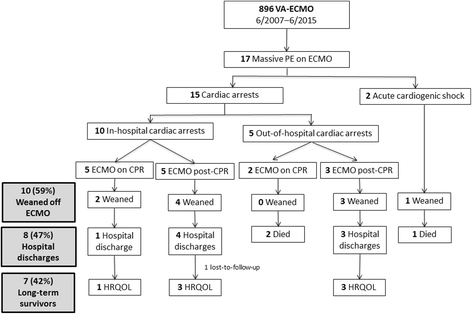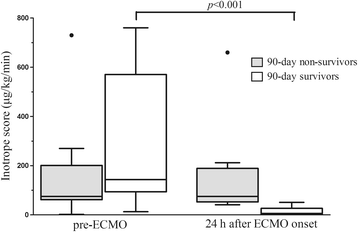Life-threatening massive pulmonary embolism rescued by venoarterial-extracorporeal membrane oxygenation
- PMID: 28347320
- PMCID: PMC5369216
- DOI: 10.1186/s13054-017-1655-8
Life-threatening massive pulmonary embolism rescued by venoarterial-extracorporeal membrane oxygenation
Abstract
Background: Despite quick implementation of reperfusion therapies, a few patients with high-risk, acute, massive, pulmonary embolism (PE) remain highly hemodynamically unstable. Others have absolute contraindication to receive reperfusion therapies. Venoarterial-extracorporeal membrane oxygenation (VA-ECMO) might lower their right ventricular overload, improve hemodynamic status, and restore tissue oxygenation.
Methods: ECMO-related complications and 90-day mortality were analyzed for 17 highly unstable, ECMO-treated, massive PE patients admitted to a tertiary-care center (2006-2015). Hospital- discharge survivors were assessed for long-term health-related quality of life. A systematic review of this topic was also conducted.
Results: Seventeen high-risk PE patients [median age 51 (range 18-70) years, Simplified Acute Physiology Score II (SAPS II) 78 (45-95)] were placed on VA-ECMO for 4 (1-12) days. Among 15 (82%) patients with pre-ECMO cardiac arrest, seven (41%) were cannulated during cardiopulmonary resuscitation, and eight (47%) underwent pre-ECMO thrombolysis. Pre-ECMO median blood pressure, pH, and blood lactate were, respectively: 42 (0-106) mmHg, 6.99 (6.54-7.37) and 13 (4-19) mmol/L. Ninety-day survival was 47%. Fifteen (88%) patients suffered in-ICU severe hemorrhages with no impact on survival. Like other ECMO-treated patients, ours reported limitations of all physical domains but preserved mental health 19 (4-69) months post-ICU discharge.
Conclusions: VA-ECMO could be a lifesaving rescue therapy for patients with high-risk, acute, massive PE when thrombolytic therapy fails or the patient is too sick to benefit from surgical thrombectomy. Because heparin-induced clot dissolution and spontaneous fibrinolysis allows ECMO weaning within several days, future studies should investigate whether VA-ECMO should be the sole therapy or completed by additional mechanical clot-removal therapies in this setting.
Keywords: Cardiogenic shock; Extracorporeal membrane oxygenation; Long-term quality of life; Massive pulmonary embolism.
Figures



References
-
- Kasper W, Konstantinides S, Geibel A, Olschewski M, Heinrich F, Grosser KD, Rauber K, Iversen S, Redecker M, Kienast J. Management strategies and determinants of outcome in acute major pulmonary embolism: results of a multicenter registry. J Am Coll Cardiol. 1997;30(5):1165–71. doi: 10.1016/S0735-1097(97)00319-7. - DOI - PubMed
MeSH terms
LinkOut - more resources
Full Text Sources
Other Literature Sources
Medical

